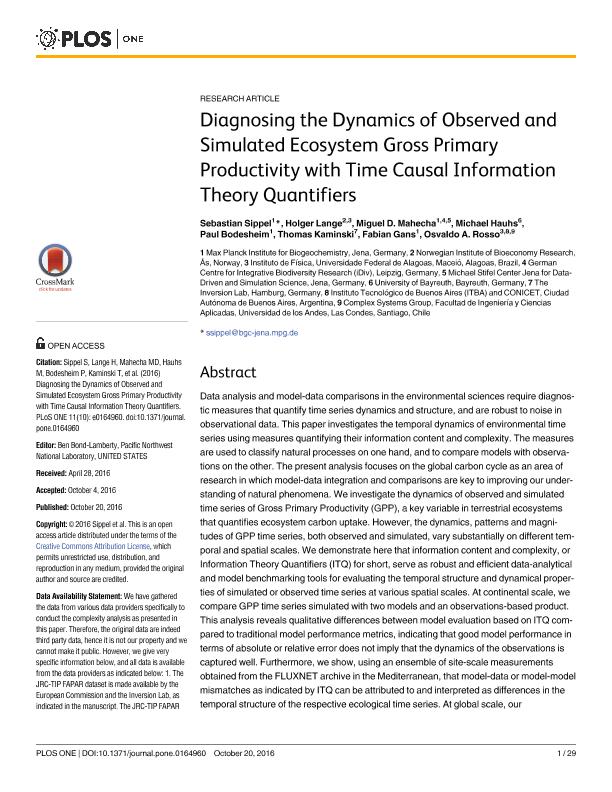Mostrar el registro sencillo del ítem
dc.contributor.author
Sippel, Sebastian
dc.contributor.author
Lange, Holger
dc.contributor.author
Mahecha, Miguel D.
dc.contributor.author
Hauhs, Michael
dc.contributor.author
Bodesheim, Paul
dc.contributor.author
Kaminski, Thomas
dc.contributor.author
Gans, Fabian
dc.contributor.author
Rosso, Osvaldo Aníbal

dc.date.available
2018-05-31T13:44:15Z
dc.date.issued
2016-10
dc.identifier.citation
Sippel, Sebastian; Lange, Holger; Mahecha, Miguel D.; Hauhs, Michael; Bodesheim, Paul; et al.; Diagnosing the Dynamics of Observed and Simulated Ecosystem Gross Primary Productivity with Time Causal Information Theory Quantifiers; Public Library of Science; Plos One; 11; 10; 10-2016; 1-45; e0164960
dc.identifier.uri
http://hdl.handle.net/11336/46762
dc.description.abstract
Data analysis and model-data comparisons in the environmental sciences require diagnostic measures that quantify time series dynamics and structure, and are robust to noise in observational data. This paper investigates the temporal dynamics of environmental time series using measures quantifying their information content and complexity. The measures are used to classify natural processes on one hand, and to compare models with observations on the other. The present analysis focuses on the global carbon cycle as an area of research in which model-data integration and comparisons are key to improving our understanding of natural phenomena. We investigate the dynamics of observed and simulated time series of Gross Primary Productivity (GPP), a key variable in terrestrial ecosystems that quantifies ecosystem carbon uptake. However, the dynamics, patterns and magnitudes of GPP time series, both observed and simulated, vary substantially on different temporal and spatial scales. We demonstrate here that information content and complexity, or Information Theory Quantifiers (ITQ) for short, serve as robust and efficient data-analytical and model benchmarking tools for evaluating the temporal structure and dynamical properties of simulated or observed time series at various spatial scales. At continental scale, we compare GPP time series simulated with two models and an observations-based product. This analysis reveals qualitative differences between model evaluation based on ITQ compared to traditional model performance metrics, indicating that good model performance in terms of absolute or relative error does not imply that the dynamics of the observations is captured well. Furthermore, we show, using an ensemble of site-scale measurements obtained from the FLUXNET archive in the Mediterranean, that model-data or model-model mismatches as indicated by ITQ can be attributed to and interpreted as differences in the temporal structure of the respective ecological time series. At global scale, our understanding of C fluxes relies on the use of consistently applied land models. Here, we use ITQ to evaluate model structure: The measures are largely insensitive to climatic scenarios, land use and atmospheric gas concentrations used to drive them, but clearly separate the structure of 13 different land models taken from the CMIP5 archive and an observations-based product. In conclusion, diagnostic measures of this kind provide data-analytical tools that distinguish different types of natural processes based solely on their dynamics, and are thus highly suitable for environmental science applications such as model structural diagnostics.
dc.format
application/pdf
dc.language.iso
eng
dc.publisher
Public Library of Science

dc.rights
info:eu-repo/semantics/openAccess
dc.rights.uri
https://creativecommons.org/licenses/by-nc-sa/2.5/ar/
dc.subject
Information Theory Quantifiers
dc.subject
Time Series Analysis
dc.subject
Gross Primary Productivity
dc.subject.classification
Otras Ciencias Físicas

dc.subject.classification
Ciencias Físicas

dc.subject.classification
CIENCIAS NATURALES Y EXACTAS

dc.title
Diagnosing the Dynamics of Observed and Simulated Ecosystem Gross Primary Productivity with Time Causal Information Theory Quantifiers
dc.type
info:eu-repo/semantics/article
dc.type
info:ar-repo/semantics/artículo
dc.type
info:eu-repo/semantics/publishedVersion
dc.date.updated
2018-05-30T14:28:47Z
dc.identifier.eissn
1932-6203
dc.journal.volume
11
dc.journal.number
10
dc.journal.pagination
1-45; e0164960
dc.journal.pais
Estados Unidos

dc.journal.ciudad
San Francisco
dc.description.fil
Fil: Sippel, Sebastian. Max Planck Institute for Biogeochemistry; Alemania
dc.description.fil
Fil: Lange, Holger. Norwegian Institute of Bioeconomy Research; Noruega. Universidade Federal de Alagoas; Brasil
dc.description.fil
Fil: Mahecha, Miguel D.. Max Planck Institute for Biogeochemistry; Alemania. German Centre for Integrative Biodiversity Research; Alemania. Michael Stifel Center Jena for Data-Driven and Simulation Science; Alemania
dc.description.fil
Fil: Hauhs, Michael. University of Bayreuth; Alemania
dc.description.fil
Fil: Bodesheim, Paul. Max Planck Institute for Biogeochemistry; Alemania
dc.description.fil
Fil: Kaminski, Thomas. The Inversion Lab; Alemania
dc.description.fil
Fil: Gans, Fabian. Max Planck Institute for Biogeochemistry; Alemania
dc.description.fil
Fil: Rosso, Osvaldo Aníbal. Universidade Federal de Alagoas; Brasil. Instituto Tecnológico de Buenos Aires; Argentina. Universidad de los Andes; Chile. Consejo Nacional de Investigaciones Científicas y Técnicas; Argentina
dc.journal.title
Plos One

dc.relation.alternativeid
info:eu-repo/semantics/altIdentifier/doi/https://dx.doi.org/10.1371/journal.pone.0164960
dc.relation.alternativeid
info:eu-repo/semantics/altIdentifier/url/http://journals.plos.org/plosone/article?id=10.1371/journal.pone.0164960
Archivos asociados
